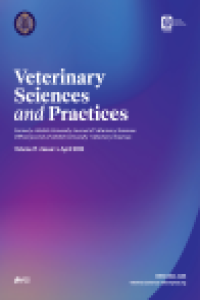Nematod Caenorhabditis Elegans'ın Oksijen Seviyesine Bağlı Hareket ve Sürü Oluşturma Davranışının Belirlenmesi
C. elegans, hareket, sürü
Investigation of oxygen-dependent motility and swarming behavior in nematode Nematode Caenorhabditis Elegans
C. elegans, hareket, sürü,
___
- 1. Martínez AE, Gomez JP, Ponciano JM, Robinson SK. Functional traits, flocking propensity, and perceived predation risk in an Amazonian understory bird community. Am Nat. 2016;187(5):607-619.
- 2. Miller N, Gerlai R. From schooling to shoaling: patterns of collective motion in zebrafish (Danio rerio). PLOS ONE. 2012;7(11):e48865.
- 3. Guo XJ, Yu Q, Chen D, et al. 4-Vinylanisole is an aggregation pheromone in locusts. Nature. 2020;584(7822):584-588.
- 4. Matthews GA. New technology for desert locust control. Agron Basel. 2021;11(6).
- 5. Hollis JP. Induced swarming of a nematode as a means of isolation. Nature. 1958;182(4640):956-957.
- 6. Guisnet A, Maitra M, Pradhan S, Hendricks M. A three-dimensional habitat for C. elegans environmental enrichment. PLoS One. 2021;16(1):e0245139.
- 7. Coulson A, Sulston J, Brenner S, Karn J. Toward a physical map of the genome of the nematode Caeno rhabd itis- elega ns. Proc Natl Acad Sci U S A. 1986;83(20):7821-7825.
- 8. White JG, Southgate E, Thomson JN, Brenner S. The structure of the nervous-system of the nematode Caeno rhabd itis- elega ns. Philos T R Soc B Biol Sci. 1986;314(1165):1-340.
- 9. Kocabas A, Shen CH, Guo ZV, Ramanathan S. Controlling interneuron activity in Caenorhabditis elegans to evoke chemotactic behaviour. Nature. 2012;490(7419):273-277.
- 10. Demir E, Yaman YI, Basaran M, Kocabas A. Dynamics of pattern formation and emergence of swarming in Caenorhabditis elegans. eLife. 2020;9.
- 11. de Bono M, Bargmann CI. Natural variation in a neuropeptide Y receptor homolog modifies social behavior and food response in C-elegans. Cell. 1998;94(5):679-689.
- 12. de Bono M, Tobin DM, Davis MW, Avery L, Bargmann CI. Social feeding in Caenorhabditis elegans is induced by neurons that detect aversive stimuli. Nature. 2002;419(6910):899-903.
- 13. Rogers C, Persson A, Cheung B, de Bono M. Behavioral motifs and neural pathways coordinating O2 responses and aggregation in C. elegans. Curr Biol. 2006;16(7):649-659.
- 14. Solon AP, Stenhammar J, Cates ME, Kafri Y, Tailleur J. Generalized thermodynamics of motility-induced phase separation: phase equilibria, Laplace pressure, and change of ensembles. New J Phys. 2018;20(7).
- 15. Cates ME, Tailleur J, Phase M-I. Separation. Annu Rev Conden Ma. 2015;P 6:219-244.
- 16. Gonnella G, Marenduzzo D, Suma A, Tiribocchi A. Motility-induced phase separation and coarsening in active matter. C R Phys. 2015;16(3):316-331.
- 17. Li YI, Cates ME. Hierarchical microphase separation in non-conserved active mixtures. Eur Phys J E Soft Matter. 2021;44(9):119.
- 18. Fausti G, Tjhung E, Cates ME, Nardini C. Capillary interfacial tension in active phase separation. Phys Rev Lett. 2021;127(6):068001.
- 19. Gray JM, Karow DS, Lu H, et al. Oxygen sensation and social feeding mediated by a C-elegans guanylate cyclase homologue. Nature. 2004;430(6997):317-322.
- 20. Yang XB, Manning ML, Marchetti MC. Aggregation and segregation of confined active particles. Soft Matter. 2014;10(34):6477-6484.
- Başlangıç: 2022
- Yayıncı: Atatürk Üniversitesi
Özgen KILIÇ ERKEK, Gülşah GÜNDOĞDU, Mehmet ALPUA, Melek BOR KÜÇÜKATAY
Çiğ Süt Örneklerinde Ağır Metal Düzeyinin Belirlenmesi
Burak ŞAHİN, Gülşah ÇANAKÇI ADIGÜZEL
Vankomisin’in Ratlarda Sperm Motilitesi ve Testiküler Yangı Üzerine Etkileri
Özge KANDEMİR, Emrah Hicazi AKSU
Ruhi KABAKÇI, Yasemin ÇINAR, Miyase ÇINAR
Etanersept glutamat ile indüklenen nörotoksisiteye karşı nöronları korur: Bir in vitro çalışma
Irmak FERAH OKKAY, Ufuk OKKAY, Yeşim YENİ, Özge BALPINAR, Ahmet HACIMÜFTÜOĞLU
